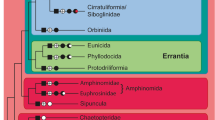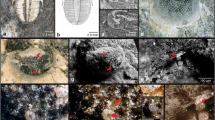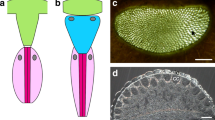Summary
Caecilians (Amphibia, Gymnophiona) have been reported to have ‘vestigial’ eyes, to lack some or all of the extrinsic eye muscles and their nerves, and to utilize eye muscles and glands, or derivatives of them, to effect movement of the tentacle, a chemosensory structure unique among vertebrates. Morphological evidence indicates that the eye is a functional photoreceptor in virtually all species examined, with an intact retina and optic nerve. The pattern of retention of extrinsic muscles varies. The ontogeny of the eye of Dermophis mexicanus is typical of that of most vertebrates, though components of accommodation never develop. Several taxa are reported in the literature to lack various eye structures; the present study reveals them to be variously present. Evolutionary trends in caecilian eye morphology include the following: (1) the eye is overlain by thicker, often glandular skin, to overlain by bone as well as skin; (2) extrinsic muscles become attenuate, and some to all may be lost; (3) the retina has the typical vertebrate layered organization, to having a reduced cell number, to becoming net-like rather than stratal; (4) the optic nerve is present, becoming attenuate, perhaps represented only by glial cells; (5) the lens is round (aquatic forms, larval and adult) to spheroid; lens crystalline to cellular (retention of the embryonic condition) to amorphous to absent; (6) the vitreous body is reduced or lost; (7) the cornea adheres to the overlying dermis or periosteum; the lens is free to adherent to cornea to adherent to both cornea and retina. Scolecomorphids have the eye pulled out of the socket and embedded in the tentacle under the skin of the upper jaw. This pattern of trends in eye reduction is similar to that observed in other vertebrate lineages that are fossorial or troglobitic.
Similar content being viewed by others
References
Alt A (1910) On the histology of the eye of Typhlotriton spelaeus, from Marble Cave, Mo. Trans Acad Sci St. Louis 19:83–96
Arnold W (1935) Das Auge von Hypogeophis. Beitrag zur Kenntnis der Gymnophionen XXVII. Morphol Jahrb 76:589–625
Brand DJ (1956) On the cranial morphology of Scolecomorphus uluguruensis (Barbour & Loweridge). Ann Univ Stellenbosch 32A:1–25
Brandon RA (1968) Structure of the eye of Haideotriton wallacei, a North American troglobitic salamander. J Morph 124:345–352
Burckhardt R (1891) Untersuchungen am Hirn und Geruchsorgan von Triton und Ichthyophis. Zeit Wiss Zool 52:369–370
de Jager E (1938) A comparison of the cranial nerves and blood-vessels of Dermophis mexicanus and Dermophis gregorii. Anat Anz 86:321–347
de Jager E (1939a) Contributions to the cranial anatomy of the Gymnophiona. Further points regarding the cranial anatomy of the genus Dermophis. Anat Anz 88:193–223
de Jager E (1939b) The cranial anatomy of Coecilia ochrocephala Cope (further contributions to the cranial morphology of the Gymnophiona). Anat Anz 88:433–469
de Villiers CGS (1936) Some aspects of the amphibian suspensorium, with special reference to the palatoquadrate and quadrato-maxillary. Anat Anz 81:225
de Villiers CGS (1938) A comparison of some cranial features of the East African Gymnophiones Boulengerula boulengeri Tornier and Scolecomorphus uluguruensis Boulenger. Anat Anz 86:1–26
Dieringer N, Precht W (1982) Compensatory head and eye movements in the frog and their contribution to stabilization of gaze. Exp Brain Res 47:394–406
Dieringer N, Precht W, Blight AR (1982) Resetting fast phases of head and eye and their linkage in the frog. Exp Brain Res 47:407–416
Dubost G (1968) Les mammiferes souterrains. Rev Ecol Biol Sol 5:99–133, 136–197
Duke-Elder S (1958) Systems of Ophthalmology. Vol 1. The Eye in Evolution. C.V. Mosby Co., St Louis
Edgeworth FH (1935) The Cranial Muscles of Vertebrates. Cambridge University Press, Cambridge
Els AJ (1963) Contributions to the cranial morphology of Schistometopum thomensis (Bocage). Ann Univ Stellenbosch 38A:39–64
Engelhardt F (1924) Tentakelapparat und Auge von Ichthyophis. Jena Z Naturwiss 60:241–305
Eigenmann CH (1909) Cave vertebrates of America. A study in degenerative evolution. Carnegie Inst Washington 104:1–241
Gundy GC (1977) Photoreceptor degeneration in the eyes of an amphisbaenian in response to constant light or constant darkness. J Exp Zool 201(2):169–176
Hanke V (1912) Die rudimentären Sehorgane einiger Amphibien und Reptilien. Arch f vergleich Ophthalmologie 6:323–342
Hawes RS (1946) On the eyes and reactions to light of Proteus anguinus. Q Rev Micros Sci 86:1–53
Hetherington TE, Wake MH (1979) The lateral line system in larval Ichthyophis (Amphibia: Gymnophiona). Zoomorph 93:209–225
Humason G (1978) Animal Tissue Techniques. W.H. Freeman, San Francisco
Kohl C (1892) Rudimentäre Wirbelthieraugen. T. Fischer's Verlag, Cassell
Kuhlenbeck H (1922) Zur Morphologie des Gymnophionengehirns. Jena Z Naturwiss 58:453–484
Leydig F (1968) Über die Schleichenlurche. Zeit Wiss Zool 18:283–286, 291–297
Manteuffel G, Plasa L, Sommer TJ, Wess O (1977) Involuntary eye movements in salamanders. Naturwiss 64:533
Marcus H (1910) Zur Entwicklungsgeschichte des Kopfes, II Teil. Beiträge zur Kenntnis der Gymnophionen IV. Festschr f R. Hertwig. 2:373–462
Nelsen OE (1956) Comparative Embryology of the Vertebrates. The Blakiston Co, New York
Norris HW (1917) The eyeball and associated structures in the blindworms. Iowa Acad Sci Proc 24:299–300
Norris HW, Hughes SP (1918) The cranial and anterior spinal nerves of the caecilian amphibians. J Morphol 31:490–557
Peter K (1898) Die Entwicklung und funktionelle Gestaltung des Schädels von Ichthyophis glutinosus. Morphol Jahrb 25:553–623
Prince JH (1956) Comparative Anatomy of the Eye. Charles C. Thomas Publ, Springfield Ill
Ramaswami LS (1941) Some aspects of the cranial morphology of Uraeotyphlus narayani Seshachar (Apoda). Rec Indian Mus Calcutta 43:143–207
Ramaswami LS (1943) An account of the head morphology of Gegenophis carnosus (Beddome), Apoda. J Mysore Univ 3:205–220
Ramaswami LS (1948) The chondrocranium of Gegenophis (Apoda Amphibia). Proc Zool Soc London 118:752–760
Rettig G, Fritzsch B, Himstedt W (1981) Development of retinofugal neuropil areas in the brain of the alpine newt, Triturus alpestris. Anat Embryol 162:163–171
Rodieck RW (1973) The Vertebrate Retina Principles of Structure and Function, W.H. Freeman Co., San Francisco
Sarasin P, Sarasin F (1887-1890) Ergebnisse naturwissenschaftlicher Forschungen auf Ceylon. Zur Entwicklungsgeschichte und Anatomie der ceylonesischen Blindwühle, Ichthyophis glutinosus. C.W. Kreidel's Verlag, Wiesbaden
Schlampp KW (1892) Das Auge des Grottenolmes (Proteus anguineus). Zeit Wiss Zool 53:537–557
Stone LS (1964) The structure and visual function of the eye of larval and adult cave salamanders Typhlotriton spelaeus. J Exp Zool 156:201–218
Storch V, Welsch U (1973) Zur Ultrastruktur von Pigmentepithel und Photoreceptoren der Seitenaugen von Ichthyophis kohtaoensis (Gymnophiona, Amphibia). Zool Jb Anat 90:160–173
Taylor EH (1968) The Caecilians of the World. A Taxonomic Review. University of Kansas Press, Larence, KA. 848 pp
Thomas K (1983) A nitrocellulose embedding technique for vertebrate morphologists. Herp Rev 14:80–81
Underwood G (1970) The Eye. In: Gans C and TS Parsons (eds) Biology of the Reptilia, Vol 2. Academic Press, New York, pp 1–97
Visser MHC (1963) The cranial morphology of Ichthyophis glutinosus (Linne) and Ichthyophis monochrous (Bleeker). Ann Univ Stellenbosch 38A:67–102
Waldschmidt J (1887) Zur Anatomie des Nervensystems der Gymnophionen. Jena Z Naturwiss 20:468–470
Walls G (1942) The Vertebrate Eye and its Adaptive Radiation. Cranbrook Institute of Science, Bull 19, Bloomfield Hills, MI
Wiedersheim R (1879) Die Anatomie der Gymnophiona. Gustav Fischer Verlag, Jena
Author information
Authors and Affiliations
Rights and permissions
About this article
Cite this article
Wake, M.H. The comparative morphology and evolution of the eyes of caecilians (Amphibia, Gymnophiona). Zoomorphology 105, 277–295 (1985). https://doi.org/10.1007/BF00312059
Received:
Issue Date:
DOI: https://doi.org/10.1007/BF00312059




